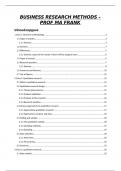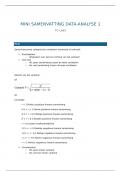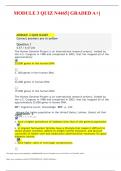BUSINESS RESEARCH METHODS –
PROF MA FRANK
Inhoudsopgave
1 Class 1: Research methodology...........................................................................................................3
1.1 Types of articles............................................................................................................................3
1.1.1 Exercise..................................................................................................................................3
1.2 Sections........................................................................................................................................4
1.3 Differences....................................................................................................................................5
1.3.1 Exercise: topics of the master’s thesis will be assigned soon.................................................6
1.4 Types of sources...........................................................................................................................6
1.5 Research question........................................................................................................................7
1.5.1 Exercise..................................................................................................................................8
1.6 Construct and theories...............................................................................................................10
1.7 Use of figures..............................................................................................................................10
2 Class 2: Qualitative research..............................................................................................................12
2.1 What is qualitative research.......................................................................................................12
2.2 Qualitative research design.........................................................................................................14
2.2.1 Theme/phenomenon...........................................................................................................15
2.2.2 Problem definition...............................................................................................................15
2.2.3 Purpose of the research.......................................................................................................16
2.2.4 Research question................................................................................................................16
2.3 Various approaches to qualitative research................................................................................17
2.3.1 Approaching qualitative research........................................................................................17
2.3.2 Approaches: purpose and data............................................................................................18
2.4 Setting and sample.....................................................................................................................18
2.4.1 The qualitative sample.........................................................................................................18
2.4.2 Sampling methods...............................................................................................................19
2.4.3 Sampling..............................................................................................................................19
2.5 Data collection............................................................................................................................20
2.5.1 Interviews............................................................................................................................20
2.5.2 Focus group.........................................................................................................................22
2.6 Summary.....................................................................................................................................25
3 Class 3: qualitative research...............................................................................................................26
3.1 Data analysis...............................................................................................................................26
, 3.1.1 Code.....................................................................................................................................26
3.2 Getting practical..........................................................................................................................28
3.3 evaluate a qualitative study........................................................................................................31
3.3.1 validity.................................................................................................................................32
3.3.2 reliability..............................................................................................................................33
3.4 summary of qualitative study.....................................................................................................33
3.5 Survey design..............................................................................................................................37
4 class 4: Quantitative research............................................................................................................44
4.1 What is quantitative research ?..................................................................................................44
4.2 quantitative research design.......................................................................................................44
4.3 hypotheses.................................................................................................................................45
4.4 Quantitative approaches or research methods...........................................................................46
4.5 surveys........................................................................................................................................47
4.6 Experimental research (vignette studies)....................................................................................61
5 Class 5................................................................................................................................................66
5.1 nvivo...........................................................................................................................................66
2
,1 CLASS 1: RESEARCH METHODOLOGY
The research process
- Choosing and defining a research topic
- Review literature critically
- Formulate research questions and objectives
- Determine research method
- Drawing up a research design (action plan)
- Data collection
- Data analysis
- Reporting
1.1 TYPES OF ARTICLES
- Original Research: the most common type of journal manuscript used to publish full reports
of data from research
- Short reports or Letters: communicate brief reports of data from original research that
editors believe will be interesting to many researchers, and that will likely stimulate further
research in the field
- Review Articles: provide a comprehensive summary of research on a certain topic, and a
perspective on the state of the field and where it is heading. They are often written by
leaders in a particular discipline after invitation from the editors of a journal.
- Case Studies: report specific instances of interesting phenomena. A goal of Case Studies is to
make other researchers aware of the possibility that a specific phenomenon might occur.
- Methodologies or Methods: present a new method, test or procedure. The method
described may either be completely new, or may offer a better version of an existing method.
Short: communication but you don’t see any data
Review: review of all previous studies
Methodologies: motivate or promote a specific method
It can belong to more types
1.1.1 EXERCISE
• Expected output for the master's thesis
Scientific article
• In Group:
o Look up the scientific articles mentioned on the following slides in LIMO, Google Scholar or in
another way. Go through the articles diagonally.
o Note which different sections/parts an article consists of.
o Do you see differences in the type of research? If yes, what types of research can you find?
And do the sections differ depending on the type of research?
Articles
1. Locke, K., & Golden-Biddle, K. (1997). Constructing opportunities for contribution: Structuring
intertextual coherence and “problematizing” in organizational studies. Academy of Management
Journal, 40(5), 1023-1062.
2. Chenhall, R. H., Hall, M., & Smith, D. (2013). Performance measurement, modes of evaluation and the
development of compromising accounts. Accounting, Organizations and Society, 38(4), 268-287.
3. Chapman, C. S., Grabner, I., & Moers, F. (2020). Introduction to the AOS special issue on management
control as system or package. Accounting Organizations and Society, 86.
4. Mahlendorf, M. D., Martin, M. A., & Smith, D. (2023). Innovative data–use-cases in management
accounting research and practice. European Accounting Review, 1-30.
3
, 5. Anderson, S. W., Cheng, M. M., & Phua, Y. S. (2022). Influence of control precision and prior
collaboration experience on trust and cooperation in inter-organizational relationships. The Accounting
Review, 97(6), 1-22.
6. Otley, D. (2016). The contingency theory of management accounting and control: 1980–
2014. Management Accounting Research, 31, 45-62.
7. Bedford, D. S., Speklé, R. F., & Widener, S. K. (2022). Budgeting and employee stress in times of crisis:
Evidence from the Covid-19 pandemic. Accounting, Organizations and Society, 101, 101346.
8. Boell, S. K., & Cecez-Kecmanovic, D. (2014). A hermeneutic approach for conducting literature reviews
and literature searches. Communications of the Association for information Systems, 34(1), 12.
- Short reports or Letters:
o Chapman, C. S., Grabner, I., & Moers, F. (2020).
- Review Articles:
o Otley, D. (2016).
- Case Studies:
o Chenhall, R. H., Hall, M., & Smith, D. (2013).
- Methodologies or Methods:
o Mahlendorf, M. D., Martin, M. A., & Smith, D. (2023).
- Original Research:
o All others
1.2 SECTIONS
- Tittle, possibly also subtitle
Short and concise
Attract readers’ attention
You have to attract the attention and it need to be short
- Abstract
What, why, how, results
Should help the reader determine if the article is relevant
Some key words
Key words: you have to talk about them so the readers can look them up to see if the
article is interesting
- Introduction:
What, why, how
Academic and practical relevance
Structure of what follows
Tell how the result can help to result a current problem
- Literature study
Overview of existing research
Critical analysis of existing research
Key concepts/constructs and theories from the domain
Gaps in existing research/problem definition
Research questions/objectives, usually in response to the gaps or problem statement
What is the one page?
How does your study fit in the previous studies?
Pro’s and cons of the previous studies
You found the report and you analysed it and then you have to see how it fits with
your study and the previous studies
- Method
Methodological choices
4






